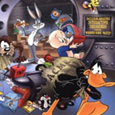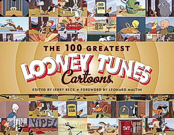 Edited by Jerry Beck
Edited by Jerry Beck
Foreword by Leonard Maltin
Insight Editions
June 15 2010
Hardcover, 240 pages
$24.95
The question must be asked: how the heck does anyone pick just 10% of the overall output from a supplier that retained an extraordinary level of quality throughout its existence? Well, that’s just what animation historian and cartoon brewmaster Jerry Beck has done for his latest book, sifting through the more than one thousand Looney Tunes and Merrie Melodies cartoons produced by Leon Schlesinger and the crazed artists at Warner Bros. Termite Terrace to deliver a somewhat definitive list compiled with the assistance of “thousands of cartoon fans, historians and animators”.
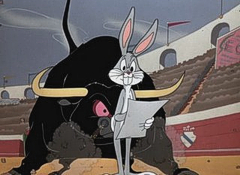 It’s hard to write an unbiased, and ultimately tough, review of the result when the reviewer is such an admirer themselves of the wonderful work the author/editor has done over the years to keep classic animation alive (just as much in reminding the Studios of what they own and should make available as being a champion for the fans who lap it all up), but I have to say the final product, while being tremendously good value and absolutely lavishly illustrated with frame stills, rare art and a smattering of original posters, doesn’t quite make The 100 Greatest Looney Tunes an absolutely essential addition to the line up of such books, many of which Jerry had a hand in too, of course.
It’s hard to write an unbiased, and ultimately tough, review of the result when the reviewer is such an admirer themselves of the wonderful work the author/editor has done over the years to keep classic animation alive (just as much in reminding the Studios of what they own and should make available as being a champion for the fans who lap it all up), but I have to say the final product, while being tremendously good value and absolutely lavishly illustrated with frame stills, rare art and a smattering of original posters, doesn’t quite make The 100 Greatest Looney Tunes an absolutely essential addition to the line up of such books, many of which Jerry had a hand in too, of course.
We’ll get to the choices of cartoons in a moment but I think, for me personally, the slight disappointment initially came with the design side of things, beginning with the size of the book. In retrospect, after holding it in my hands and frantically dipping through the pages to see if my favorites have been included, I actually now think the proportions are perfect (at roughly nine inches wide by seven inches tall by one inch thick, or slightly bigger than an oversized DVD package), but given the publicity images one could have assumed it would be twice as big, or the size of a typical Art Of… tome.
While that would have made for something quite spectacular, I wonder if the quality of some of the frame blow-ups or final consumer cost was a factor here (certainly similar books usually go for twice the price). The result is a volume that feels like a miniaturized edition, and some of the text may seem particularly small for some older readers, although as I say, after a while it starts to feel just right – like a snazzy little book that deals with a zippy subject.
 But the design doesn’t always work, and it’s mostly to do with the images: we’re now used to seeing Jpeg images of cartoon posters on the net, but few of us get to see them up close on printed paper. The book opens with several poster reproductions, but instead of being able to study the art, they’re zoomed in to select detail, also desaturating color (if any; most WB cartoon posters were black and white to begin with) so as to tint the pages in reds, yellows, blues, etc. It works as a tease to the book, but maybe “The 100 Greatest Looney Tunes Posters” is something that might come along in the future?
But the design doesn’t always work, and it’s mostly to do with the images: we’re now used to seeing Jpeg images of cartoon posters on the net, but few of us get to see them up close on printed paper. The book opens with several poster reproductions, but instead of being able to study the art, they’re zoomed in to select detail, also desaturating color (if any; most WB cartoon posters were black and white to begin with) so as to tint the pages in reds, yellows, blues, etc. It works as a tease to the book, but maybe “The 100 Greatest Looney Tunes Posters” is something that might come along in the future?
Now, it’s true that more posters pop up throughout, but for me there aren’t enough, with the book leaning too heavily on frame stills from the cartoons themselves – some great, presumably from recently restored HD masters, and some not so great, presumably from the best available transfers perhaps from the LaserDisc days. Jerry himself was instrumental in bringing a terrific amount of gems from the Warner Bros. vault to LD in the 1990s with The Golden Age Of Looney Tunes collections of pre-1948 cartoons, then owned by MGM and, later when Warners had bought back their own library through Ted Turner, was heavily involved in the production of The Looney Tunes Golden Collection DVD volumes.
Although Jerry does consult for other studios, it’s the work of directors such as Chuck Jones, Friz Freleng, Bob McKimson, Tex Avery, Frank Tashlin and many more from Warners’ glory days that we mostly associate with his vast knowledge of animation. As such, he’s just about the best placed man for the job of editing this listing – presented tellingly in alphabetical order instead of chronologically or by numbered ranking, which would have been nigh on impossible. And one hundred slots sounds just about right: twenty five would never have done any list justice, and even fifty would have left too many without the chance to make their impact.
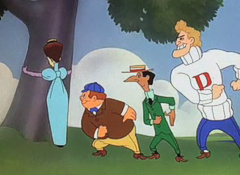 While Jerry was busy shepherding the MGM LaserDisc collections of the 1990s, the post-1948 cartoons that Warners still held were distributed in one-shot compilations often hosted by Leonard Maltin, who contributes an entertaining foreword for his old friend here and elaborates on who the book is perhaps best aimed at: not the collectors that already own many of these cartoons, but the newcomers who may be encouraged to locate them and become inspired themselves.
While Jerry was busy shepherding the MGM LaserDisc collections of the 1990s, the post-1948 cartoons that Warners still held were distributed in one-shot compilations often hosted by Leonard Maltin, who contributes an entertaining foreword for his old friend here and elaborates on who the book is perhaps best aimed at: not the collectors that already own many of these cartoons, but the newcomers who may be encouraged to locate them and become inspired themselves.
Jerry’s introduction fills newcomers in further before the list begins proper, fittingly with Jones’ From A To Z-z-z-z. Each title is treated to the same breakdown: a bold-type synopsis (which can sometimes take up too much room), a choice quote, a credits block of production details, comments (which sometimes don’t take up enough room) from one of the many animation authorities (Mike Barrier, John Canemaker, David Gerstein, Eric Goldberg and Mark Kausler among 30 others), as well as release date info and, on occasion, an additional “Jerry Says” slice of trivia, all of which gives a nice overview of any of the shorts.
However, long-time fans and those that have slavishly collected these cartoons and information on them, from television documentaries, LaserDisc and DVD compilations, may not find much “new” to them: the enjoyment is more to be found in simply revisiting these cartoons and seeing which have been picked, or not. And the listing is pretty good, the selections being from the (a little stretched) “golden age” of animation of 1930-1969 (or, rather, the life of the synchronized sound cartoon short), perhaps inevitably canceling out any more recent attempts.
 The majority need no introduction (Ali Baba Bunny, A Corny Concerto, Duck Amuck, Falling Hare, One Froggy Evening, Rabbit Of Seville, Robin Hood Daffy, What’s Opera, Doc?), but it’s nice to see non-character shorts (High Note, The Three Little Bops) included too. There’s also a fair mix between old and new, with the black and white and early color years (Book Revue, Cinderella Meets Fella, I Love To Singa, Porky In Wackyland, You Ought To Be In Pictures) mixing with some Wartime and Censored 11 picks (Russian Rhapsody, Coal Black And De Sebben Dwarfs) and the later 1950s (including Jones’ classic Bugs-Daffy-Elmer “Hunting Trilogy”; though a note that 1952’s Rabbit Seasoning is misstated as a 1950 release).
The majority need no introduction (Ali Baba Bunny, A Corny Concerto, Duck Amuck, Falling Hare, One Froggy Evening, Rabbit Of Seville, Robin Hood Daffy, What’s Opera, Doc?), but it’s nice to see non-character shorts (High Note, The Three Little Bops) included too. There’s also a fair mix between old and new, with the black and white and early color years (Book Revue, Cinderella Meets Fella, I Love To Singa, Porky In Wackyland, You Ought To Be In Pictures) mixing with some Wartime and Censored 11 picks (Russian Rhapsody, Coal Black And De Sebben Dwarfs) and the later 1950s (including Jones’ classic Bugs-Daffy-Elmer “Hunting Trilogy”; though a note that 1952’s Rabbit Seasoning is misstated as a 1950 release).
The comments from the various contributors vary from sometimes repeating chunks of the cartoons’ plotlines to very insightful and succinct points, often depending on the writer and the notability of the particular cartoon. In a rare occurrence for these kinds of lists, I don’t think there’s one cartoon in The 100 Greatest Looney Tunes Cartoons that doesn’t belong and although I’m not fond of every selection here, I can see why they’ve made the cut. Of course, such opinion is personal and, just as the listing is as definitive as one could expect – as well as the expected character choices, there’s a healthy reliance on one-shot cartoons – there are some cartoons or characters that don’t feature.
I was surprised at omissions for Transylvania 6-5000, For Scent-imental Reasons, Knighty Knight Bugs, Hyde And Go Tweet, Gee Whiz-z-z-z-z-z-z and any number of others, and missed any real showings for Foghorn Leghorn, Tasmanian Devil and Pepe Le Pew (all of which featured in series highlights, although Egghead and Speedy Gonzales make brief appearances). But while there is a leaning on the more zany Tunes and Melodies that we remember as coming from Termite Terrace, I was pleased to see some earlier, cuter styled shorts which, while not as typical to the series, provides the evidence that the crew could also turn out beautiful “Disney style” animation (Old Glory, Pigs Is Pigs) – even if that’s not to say the wild takes the Tunes were known for are not beautiful in their own way too!
 Each is illustrated – as best as they can be on the printed page – by scores of frame stills, though much of the kineticism is lost, prompting the suggestion that the best way to enjoy the films is to see them for real. Which is why I was disappointed that more “behind the scenes” art wasn’t used: there are some poster repros, and the occasional model sheet, but for the most part the book is filled (and “filled” is the right word!) with frame stills which, again while probably appealing to the newcomer, won’t give collectors and fans much of anything they haven’t already seen before. I’d have much preferred some storyboards or artist photos to some of the many stills, or even more text exploring each cartoon a little deeper.
Each is illustrated – as best as they can be on the printed page – by scores of frame stills, though much of the kineticism is lost, prompting the suggestion that the best way to enjoy the films is to see them for real. Which is why I was disappointed that more “behind the scenes” art wasn’t used: there are some poster repros, and the occasional model sheet, but for the most part the book is filled (and “filled” is the right word!) with frame stills which, again while probably appealing to the newcomer, won’t give collectors and fans much of anything they haven’t already seen before. I’d have much preferred some storyboards or artist photos to some of the many stills, or even more text exploring each cartoon a little deeper.
As such, The 100 Greatest Looney Tunes Cartoons finds itself on either end of the spectrum: as an overview reference book for those that need a little background info on the series the book works fine, while it will also appeal to really hard-core collectors that must have everything Looney Tunes or who follow and collect each printed edition of Jerry Beck and Leonard Maltin’s work. But those casual fans, even the ones that continued purchasing the Golden Collection DVDs until their last breath (as for those who didn’t, oh the gems you missed out on!), may simply find it, as Maltin’s foreword says, “a trip down memory lane”.
However, it’s a very nice trip down memory lane, wonderfully printed on heavy stock, glossy paper and, although the lack of posters (or even title cards?) for each entry is a missed opportunity, the sheer quality of the book and its page count can not be dismissed out of hand; despite the smaller than anticipated size it certainly represents excellent value for money at less than $25 (even less online, where it’s practically a steal), which I had to check again wasn’t a misprint!
Ultimately, The 100 Greatest Looney Tunes Cartoons doesn’t cover as much ground as previous volumes on the animated output of the Warner Bros. Studio, but there’s a quality to it that suggests most would probably rather have it on their shelves than not, perhaps as an additional supplement to their LD and DVD collections, which it suitably compliments.
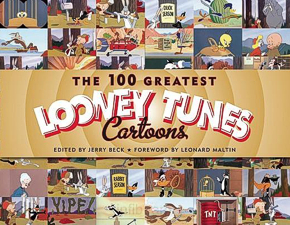
is available to buy now from Amazon.com




